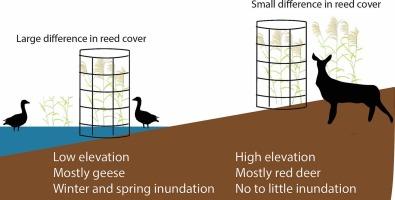多年的水位下降和野生动物放牧驱动湿地植被演替
IF 4.1
2区 环境科学与生态学
Q1 ECOLOGY
引用次数: 0
摘要
在湿地中,多年的水位下降和草食可以诱导植被的循环演替。虽然水位下降可以用于湿地管理,以增加芦苇植被的面积,芦苇植被是湿地鸟类的重要栖息地,但草食可能会干扰这一过程。本文研究了人为引起的水位下降(即有意的、暂时的、大规模的水位下降)和食草动物对湿地植被发育的综合影响。在Oostvaardersplassen湿地,我们使用卫星图像评估了有无水位下降以及有无马鹿(1992年引入)的植被发展情况。一项跨海拔梯度的草食动物圈闭实验(2022-2024)测试了在下降期间放牧对植被发育的影响。卫星图像显示,在没有马鹿的时期(1987-1991),芦苇覆盖面积扩大了560公顷,有马鹿的时期(2020-2024),芦苇覆盖面积扩大了420公顷,仅在减少的地区。封闭实验强调了草食和水深之间的相互作用:干燥地区马鹿的存在对芦苇膨胀的影响较小,而潮湿地区鹅的存在则强烈抑制芦苇膨胀。我们的研究结果提供了大规模的定量证据,证明水位下降和草食在芦苇为主的湿地恢复中的相互作用。我们展示了当干旱条件可以连续保持数年时,水位下降作为促进芦苇发育的恢复工具的有效性,以及在恢复过程中引导食草动物影响的潜力。本文章由计算机程序翻译,如有差异,请以英文原文为准。

Multi-year water level drawdown and wildlife grazing drive wetland vegetation succession
In wetlands, multi-annual water level drawdowns and herbivory can induce cyclic vegetation succession. While water level drawdowns can be used in wetland management to increase the area of reed vegetation, an important habitat for wetland birds, herbivory may interfere with this process. Here, we studied the combined effects of a human-induced water level drawdown, i.e. the intentional temporarily and large scale lowering of the water level, and herbivores on wetland vegetation development.
In the Oostvaardersplassen wetland, we used satellite imagery to assess vegetation development with and without water level drawdown and with and without red deer presence (introduced in 1992). An herbivore exclosure experiment (2022–2024) across an elevational gradient tested the effect of grazing on vegetation development during a drawdown.
Satellite imagery showed an expansion of reed cover by 560 ha in the period without red deer (1987–1991) and by 420 ha with red deer (2020–2024), only in the area with drawdowns. The exclosure experiment highlighted an interaction between herbivory and water depth: The presence of red deer at drier locations had minor effects on reed expansion, whereas reed expansion was strongly inhibited at wet locations with presence of geese.
Our findings provide large-scale quantitative evidence of the interaction between a water level drawdown and herbivory on the restoration of reed-dominated wetlands. We show the effectiveness of a water level drawdown, when dry conditions can be maintained for several consecutive years, as a restoration tool to promote reed development and the potential to steer the impact of herbivores during restoration.
求助全文
通过发布文献求助,成功后即可免费获取论文全文。
去求助
来源期刊

Ecological Engineering
环境科学-工程:环境
CiteScore
8.00
自引率
5.30%
发文量
293
审稿时长
57 days
期刊介绍:
Ecological engineering has been defined as the design of ecosystems for the mutual benefit of humans and nature. The journal is meant for ecologists who, because of their research interests or occupation, are involved in designing, monitoring, or restoring ecosystems, and can serve as a bridge between ecologists and engineers.
Specific topics covered in the journal include: habitat reconstruction; ecotechnology; synthetic ecology; bioengineering; restoration ecology; ecology conservation; ecosystem rehabilitation; stream and river restoration; reclamation ecology; non-renewable resource conservation. Descriptions of specific applications of ecological engineering are acceptable only when situated within context of adding novelty to current research and emphasizing ecosystem restoration. We do not accept purely descriptive reports on ecosystem structures (such as vegetation surveys), purely physical assessment of materials that can be used for ecological restoration, small-model studies carried out in the laboratory or greenhouse with artificial (waste)water or crop studies, or case studies on conventional wastewater treatment and eutrophication that do not offer an ecosystem restoration approach within the paper.
 求助内容:
求助内容: 应助结果提醒方式:
应助结果提醒方式:


